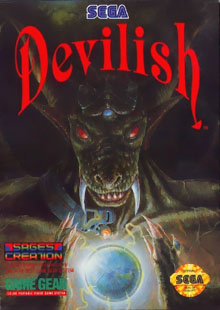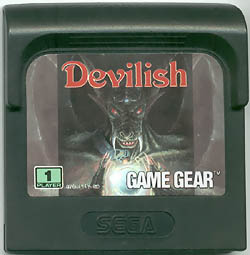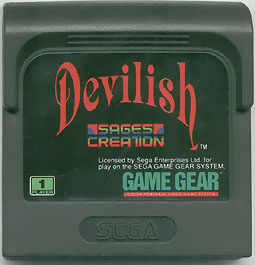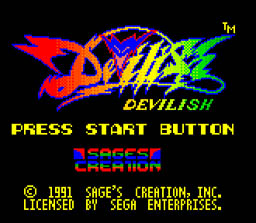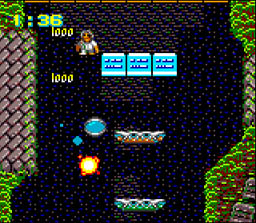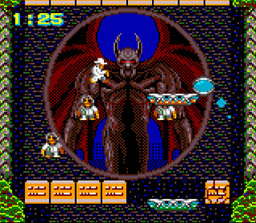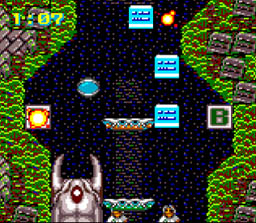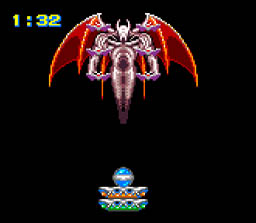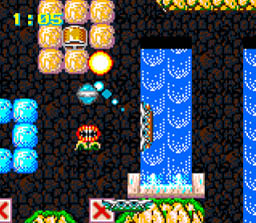|
Genki...who are they? In recent years, they have become known for "Shutokou Battle" (known in the U.S. as Tokyo Highway Battle) and "Tamamayu Monogatari" (known in the U.S. as Jade Cocoon) games. They have made a name for themselves and are now known among mainstream and hardcore gamers alike. However, what about back in the days of old when they were new to the gaming world? Back in 1990 when Genki was founded, few people knew anything about them or that they even existed. You could have played a game from them and you may have never even known it. Devilish just so happens to be one of those games that fits that bill.
Whether you played the Hot-B published version or the Sage's Creation version, Genki's name is not mentioned anywhere! This is strange since it is the first product the developers have made! There is a port of Devilish on the Sega Genesis, and while it has a basic introduction that tells you what the game is about, the Game Gear game does not. You should know that the basic plot deals with a prince and princess who loved each other very much. One day, a jealous demon named Gamma (or "y", which can mean "Gamma" in the Greek alphabet), turns the couple into paddles to leave them helpless as he takes over the kingdom. Out of nowhere, a glowing orb appears and with it, you must use its power to defeat the demons in your path and become normal again.
For one of the earliest Game Gear games, Devilish manages to showcase respectable visuals. Certain background details are quite nice for an old handheld title such as giant eyeballs in the walls that look around the area or glowing magma on the volcano stage. You travel through an ice cave, volcano, and other areas as you fight to reach Gamma and they aren't an eyesore. The game has a couple of little explosion effects and the game attempts to hide the limited assortment of colors by making things glow within the environment to make the game feel more animated. I also like the animation of the second level boss where several bats join together to transform into a giant winged demon. There is some slowdown in certain parts of the game, but given the style of the game and the year, Devilish looks pretty good and the slowdown shouldn't be a hindrance.
While you blast your way through the demon infested environments, you are presented with some music that nicely accompanies each stage. I feel that the first stage tune is the finest of the bunch, but the rest are also good and serve their purpose. The music strangely reminds me of something from the NES version of Sky Shark by Taito (with the conversion being done by Software Creations). Although Devilish's title makes the game sound dark and eerie, it's good to know that the music (what little is present) offers more variety than what one may suspect and the music is actually pretty good. The sound effects are generally the standard fare with bloops, bleeps, and the appropriate (though not realistic) explosion sounds. Such sounds were acceptable in 1991 and the Game Gear handheld.
Devilish looks like a Breakout game on the surface, but don't be fooled by appearances. The developers added a little twist to the old-school classic so that it wouldn't seem so simple and ordinary. The end result was a game that had the basic Breakout formula, but required players to go through twisting paths while defeating monsters and destroying obstacles. Devilish does not require the player to simply use a ball to eliminate all the blocks on the screen. You must actually guide the ball to an exit at the end of each level and you have a limited amount of time to do so. As you destroy the obstacles in your path, you will progress further through the level. You have powerups that can be obtained by using the ball to hit treasure boxes. You can get extra lives, a "super ball" that easily destroys enemies and objects, extra time, and a bomb that destroys many objects on-screen (it is automatically used when you grab it). You must avoid hitting boxes marked with an "X" on them or your paddles will temporarily shrink. During certain level segments, you will reach a part of the stage where you have to go left or right (only one way or the other, not both). How is that possible?
Well, Devilish lets you use two paddles to guide the ball, with one being the typical paddle that you would use to bounce the ball back and the other paddle is meant to be used to guide the ball with ease. You can use four different paddle formations. The standard formation has one paddle directly above the other one. One formation has the lower paddle split into two smaller paddles while the top paddle remains unchanged (giving you three paddles) and it is meant to make it easy to catch the ball even if it were to bounce towards the exact opposite side of the screen quickly. The other two formations have the bottom paddle remain unchanged while the top paddle is positioned to face the left or right. Instead of being horizontal like the bottom paddle, the top paddle becomes vertical (it turns 90 degrees) and you can use those two formations to help you guide the ball down paths that go left or right. You can also change the speed of your paddle to move at speeds of Mach 1, 2, or 3. If you want to put your skills to the test, you can practice on six stages in the Time Trial mode (though the game has eight stages total) and the game gives you basic options such as changing difficulty, adjusting the amount of lives you start with, and you can listen to the music and sounds.
I only have two complaints about Devilish. My first complaint lies in the way the ball bounces off of the paddles. While the ball is still easy to guide once you get the hang of the formation system, the actual "Pong Physics" are a bit off. In other words, the way the ball rebounds when it hits the paddle is inaccurate. However, this will only prove to be a problem when you go down a left or right path. While I don't find the game challenging (with the exception of the final boss), the game may seem a little harder to some because of the physics. My second (and smaller) complaint is that there are only three bosses in the entire game even though there are eight stages. Still, when everything is said and done, Devilish manages to be a nice little game that is fun to play on the go. It's an interesting little diversion from other portable Game Gear titles, that's for sure.
- Written by Vyse the determined - |
